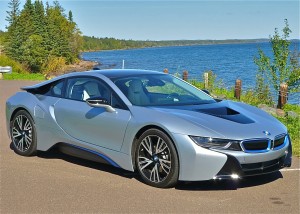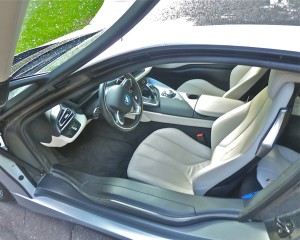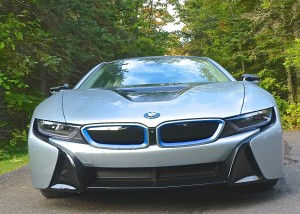If You Want a Hybrid, Would a BMW i8 Do?
By John Gilbert
Since my first turn in a 1968 2800 CS Coupe, I’ve driven virtually everything BMW has produced, which includes the 1600 and 2002, continues on through the 3-Series, 5-Series, 7-Series, the newest 1, 2 and 6 models, assorted X-model SUVs, and a couple more I’ve overlooked.
A couple of certainties follow: 1. All of them were and are impressive from an engineering and utilitarian standpoint, and 2. None of them could possibly prepare you for a drive in the i8.
The 2015 BMW i8 is the ultimate dream car. A reason-bending concept car brought to life, fulfilling fantasies and adding futuristic ideals that reach beyond those fantasies. We all have been reading about the latest global-warming, climate-changing, high-risk trends of today’s world, and the most logical conclusion is that our driving machines are going to become electrified in some manner. So why not make a lifestyle statement and make your next car a hybrid?
Also, if you live in a Northern climate, rich with snow in the winter, all-wheel drive is a nice feature. Let’s further imagine that you could buy any car on the planet — although that might be a bit harder to grasp. The i8 price tag is $136,650. If you hear the price while gazing at the car, it doesn’t seem as shocking. Especially if you have any idea of the price sticker for a Ferrari, Porsche, Maserati, Jaguar, McLaren, or Aston Martin.
As far as other subjective characteristics you and your co-driving wife might embrace, you’d obviously prefer something visually striking, maybe a great looking sporty car with the added emotional investment of performance that’s up there with the elite top exotics. The BMW i8 can meet and exceed all those fanciful ideas.
It is built of carbon-fiber, that magical material that is, they say, three times lighter and several times stronger than steel. The car weighs in at 3,378 pounds, all of which are distributed front to rear at a nearly ideal 49/51 ratio.
I hadn’t bothered to investigate the i8’s details fully since it started making the auto-show round, because I suspected it might just be a design exercise. When one appeared in my driveway in Duluth, Minnesota, however, it was time to either learn about it or find a respirator. I knew BMW had come out with an electric i3 subcompact sedan, but I still couldn’t believe the i8 had been brought to life.
For visual impact, there may be nothing else that approaches the stunning looks of the i8. If there is, it would have to be a $300,000-range super-car named Ferrari, Lamborghini, or McLaren.
The i8 is a glistening metallic silver, with a black roof panel, and black lower sides tastefully set apart by an electric-blue borderline that varies in width. That lower black wraps around the lower front end, and rises up to fully set off the rear end’s dramatic curves and layers. The i8 is so low that you feel that with a couple of hard strides you could quite easily hurdle it.
At the time, and maybe still, there had never been another i8 in Duluth, or anywhere else in Northern Minnesota — even passing through. It’s important to look cool when you’re approaching a car like this, but any semblance of patience disappeared when I popped the driver’s door, which swings upward, hinged in front, and displays the low bucket seats. You might at first overlook the fact that there are two jump seats behind those buckets, and overlooking them is probably a good idea, because a human would have to be tiny to even attempt to squeeze back there.
Never mind all that. You’re in the driver’s seat, and you have fired up the ignition and moved the shift lever into its drive slot. That takes a bit of ingenuity, just getting it out of park and past reverse. The indicator says I’ve successfully engaged first, so we’re off. The car shoots forward, instantly gaining your full respect with its super-car-like acceleration. Sounds good, too, although you ain’t heard nothing, yet.
Handling is incredible. The car is so low, with such a low center of gravity, that you feel you might become part of any road irregularities. You are encased in the bucket seat with excellent support, and snaking around turns on the curviest smooth roadway you can find is a joy to experience in the i8. Imagining it on a road-racing track is automatic, but so is straight-line acceleration.
Less attractive is planning to extricate yourself from the cockpit. Getting in is no problem, because you learn ways to go in backwards or sideways and pull in your legs later. Getting out, though, requires some gymnastic agility. I developed a partial-Western-roll, much like high-jumping form. Start to roll on your side, fling a leg out, and do a little hop-step, hoping that you land on your feet.
Driving through town is an interesting experience, because unless you’re a complete show-off, you try to avoid glancing in either direction, where everybody on either sidewalk has stopped, frozen in their tracks, to stare wide-eyed and slack-jawed at this apparition.
The only folks who might take action are those in other vehicles — even sensational other vehicles — making u-turns and following you to wherever you’re going. Pull off onto an exit ramp and the mirrors indicate you’re the lead car of a parade. You stop, and you are immediately surrounded by a herd of folks who just want to know about the car.
The i8 will shoot 0-60 in 4 seconds; maybe a couple ticks less. I have no idea what the top speed might be, although someday I’d like to find out, if a road-racing track or an autobahn becomes accessible.
It has 362 horsepower and 412 foot-pounds of torque, and we haven’t even gotten to the surprises yet.
First surprise: The engine is a 3-cylinder, measuring 1.5 liters. Huh? BMW is one of the world’s leading proponents of making engines smaller and more potent, and it makes modular sense to build engines that measure a half-liter per cylinder. A 6-cylinder measures 3.0 liters, and the 4-cylinder measures 2.0. Taking off one more cylinder leaves you with 1.5 liters.
Surprise No. 2: The tiny engine is turbocharged, making those 4-valves-per-cylinder pistons churn up and down in well-choreographed harmony.
Surprise No. 3: The i8 is a hybrid. Two electric AC-induction motors operate off a 7.1 kilowatt-hour, lithium-ion battery pack.
Surprise No. 4: The i8 has all-wheel drive. That helps it handle so dramatically well, but required precise calibration back in the factory laboratory.
Surprise No. 5: The coordination approaches miraculous. The gas engine develops 228 horsepower and the electric motors add 129 horsepower for a combined 362. The gas engine alone develops 236 foot-pounds of torque, while the electric motors add 184 more, reaching that 420 figure. The turbo gas engine powers the two rear wheels through a 6-speed automatic transmission; the two electric motors push the two front wheels via a 2-speed transmission. Coordinating it all is seamless and smooth to the driver.
As with any hybrid, a careful driver can coax a certain distance on silent electric power alone, but it takes patience. Ideally, you’d want to plug your i8 in for an hour on a 240-volt, 80-amp charger, or a bit longer on normal household 110, to get it fully charged. if you drive away and step lightly on the gas pedal, you can go silently and effortlessly for about 25 miles on pure electric. Stepping on the gas hard, or trying to accelerate quickly, brings the gas engine on to join the electric, which might be more satisfying, but cuts into your green-ness.
Gauges tell you when you’ve about exhausted the electricity, after which you’ll go on gas-engine only.
Then there’s Surprise No. 6: Pull the shift lever over to the left, into “Sport,” and you immediately get a surge both in power and in exhilaration, because the sound — helped by amplification through the speakers — is almost other-worldly with its snarling roar. It is in that Sport mode that the engine uses the gas engine’s power to help regenerate the battery pack. Recharging never sounded so sweet.
You won’t ever reach full charge with just the gas-engine input, so plugging in the i8 makes the best sense. Still, all-electric cars run impressively for a limited distance, then need to stop for several hours of recharging, no matter what time the game starts. You can keep driving on gas in the i8, and driving also juices up the battery pack enough to enjoy more full-electric driving, though for briefer stretches. Just like a “normal” hybrid.
If you owned an i8, you would develop some tricks to keep it charged and increase your effective fuel economy up to lofty heights, like maybe 75 or so miles per gallon.
Just remember that ace in the hole, for justifying such a large chunk of the family budget. Come home and announce that you’ve made the decision to help the world and your winter challenges by getting a car that is both a hybrid and an all-wheel-drive vehicle. Then let her get a glimpse of the i8 parked outside. Chances are she’ll be so blown away she won’t even ask you how much it cost.







 John Gilbert is a lifetime Minnesotan and career journalist, specializing in cars and sports during and since spending 30 years at the Minneapolis Tribune, now the Star Tribune. More recently, he has continued translating the high-tech world of autos and sharing his passionate insights as a freelance writer/photographer/broadcaster. A member of the prestigious North American Car and Truck of the Year jury since 1993. John can be heard Monday-Friday from 9-11am on 610 KDAL(www.kdal610.com) on the "John Gilbert Show," and writes a column in the Duluth Reader.
John Gilbert is a lifetime Minnesotan and career journalist, specializing in cars and sports during and since spending 30 years at the Minneapolis Tribune, now the Star Tribune. More recently, he has continued translating the high-tech world of autos and sharing his passionate insights as a freelance writer/photographer/broadcaster. A member of the prestigious North American Car and Truck of the Year jury since 1993. John can be heard Monday-Friday from 9-11am on 610 KDAL(www.kdal610.com) on the "John Gilbert Show," and writes a column in the Duluth Reader.